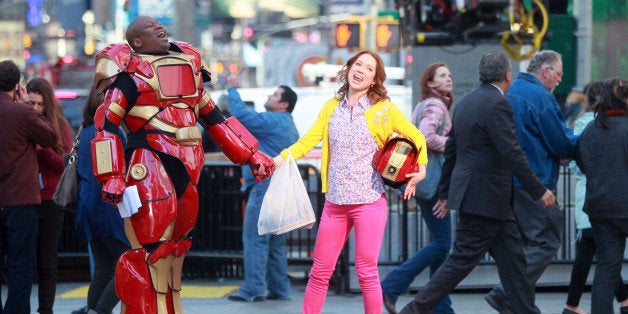
I have been obsessing over Tina Fey's new sitcom, Unbreakable Kimmy Schmidt. In fact, I just binge-watched the entire first season on Netflix for the second time. Sitcoms are not for everyone, and while this one has been criticized by some for relying on stereotypes, I find it hilarious, moving, and ultimately quite serious. Kimmy is held hostage in an underground bunker for 15 years, trapped with three other women by an abusive male religious cult leader, who takes over their lives, their bodies, and their brains. Not funny stuff, and as a gay guy who got sucked into extreme anti-gay churches that tried to de-gay me for Jesus, it hits close to home.
The series begins when Kimmy (played by brightly-dressed Ellie Kemper) and fellow female hostages are finally freed from their underground prison. Kimmy then decides to begin a new life in New York City. Having lived in a time capsule for 15 years, EVERYTHING is new to her. She romps around New York joyfully discovering all the cool stuff we now take for granted. As I fixated on the series, I realized Kimmy's story sounds a lot like mine, but in reverse.
At age 19, I moved from a little country town to NYC and immediately plunged into the underworld of Evangelical and Pentecostal Holiness churches. This was during the height of the HIV/AIDS Crisis. My pastors at the time promised that Jesus would heal me of homosexuality, so I went to church four times a week, read my Bible, and prayed at least two hours a day. I even submitted to exorcisms where the ministers attempted to drive the naughty spirits of homosexuality out of my body. One session in Brooklyn got so loud that a neighbor, assuming domestic violence, called the police.
To help with the de-gaying process, I also attended an ex-gay support group, a gay-to-straight conversion ministry that used the Bible to teach struggling homosexuals how to live holy lives free from gay sex and affectations. The weekly support meetings were chock full of gorgeous male actors who turned to the program for salvation but also to help butch them up for the straight roles they couldn't get on Broadway. (In Episode 10 of Unbreakable Kimmy Schmidt, Titus Andromedon, a Black Southern flamboyantly gay man looking for his big acting break -- portrayed by the actor Tituss Burgess pretty much playing a version of himself -- turns to a straight coach to beat the sissy boy out of him.)
Much of what I learned in gay reparative therapy sessions was not about gay sex but about gender -- how to act more manly. Their teachings included critiques of the clothes I wore -- Nehru collars were replaced with cotton polo shirts. They admonished me on the the music I enjoyed -- bye bye Bach and Celine, hello contemporary Christian music. They tampered with my day to day activities -- baking bread was a no no, but changing the oil in my own car gained me extra straight points. They instructed me on how to sit, walk, and speak like a real man.
In the churches and ex-gay programs I attended there was no greater sin than being a feminized male. I swallowed the lies and truly believed I would be more valuable if I were a straight-acting, masculine, heterosexually-leaning guy. As a result, I spent 17 years and over $30,000 on three continents trying to de-gay myself. I was Kimmy Schmidt, not in a bunker in Indiana, but in churches in New York City and around the world trapped in a Biblically-induced coma.
Then one day in Memphis, TN, after two years in the notorious Love in Action residential ex-gay program, I finally came to my senses and realized that my quest to be a straight man was not only ridiculous, it was damaging me emotionally, psychologically, and spiritually. Hallelujah, I finally broke free! But unlike Kimmy Schmidt, who enthusiastically explores the new world around her, I emerged afraid and distrustful of everyone -- straight or gay, religious or secular. I had been tricked, misinformed, and misled; I felt susceptible to it happening again. (Much like it did to Kimmy in Episode 11 when she joins a spinning class that turns out to be its own pseudo-spiritual fitness cult.)
Almost as soon as I stepped out of the closet, I felt pressured to conform to a specific pre-packaged gay identity and culture. Gay-approved music, fashion, drinks, catch phrases, interests, and ideologies were all shoved down my throat through the pages of gay media and the expectations of some of the gay folks I met. Worst of all, the gay world around me insisted that if I desired to find a mate and hoped to be useful in our collective fight for marriage equality -- the only queer cause anyone talked about -- I must present as a straight-acting, masculine gay man.
I felt panic, flashbacks to my days in a church basement on West 33rd street when religious zealots tried to beat anything feminine out of me. Sure, not all gay guys come "with feathers," as they say in Spain, but many of us were bullied for being sissies long before anyone accused us of liking other guys. Having the bitter taste of oppression still fresh in my mouth, I despaired at the thought that I escaped the ex-gay movement only to end up in the anti-fem gay community.
Fortunately at this same time I also met a vast cross-section of LGBTQ people who did not fit the mold, who allowed the many parts of themselves to get integrated into their identity -- Black bisexual gardening grandparents who quoted the Bible and Audre Lorde, justice-minded gender queer community organizers concerned about economic inequality, and an elderly trans woman who fulfilled her dream of going to the holy land to pray with the other women at the Wailing Wall -- in short people who lived their lives on their own terms.
And that is the message that shines through Unbreakable Kimmy Schmidt -- face your past, be authentic, and be fully alive. I find joy today in living my life as a quirky, queer Quaker, a gay person of faith living in rural Pennsylvania passionate about climate change as a justice issue and how to make the perfect frittata. There is an exhilaration that comes with growing comfortable in one's own skin regardless of what the collective has to say about. Watching Kimmy Schmidt navigate her new world, I recognize that after breaking out of my bunker-like closet, I did not simply come out gay. No, day by day I come out more and more as myself.
